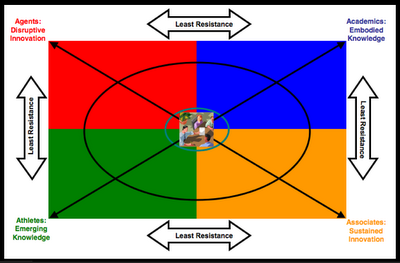Reports from the Knowledge Labs about our recent findings, research topics, and interviews with lifestyle leaders who are creating their own futures.
|
|
| |
How to stimulate your own powers of foresight. Consider the following thought provokers. Ask yourself, in these categories what are the brand new trends and forces? Which are the ones growing in importance? Which current forces are loosing their steam? Which have peaked or are reversing themselves? Which are the "wildcards" about to disrupt us in the future? POLITICAL AND TECHNICAL thought for food: Electronics, Materials, Energy, Fossil, Nuclear, Alternative, Other, Manufacturing (techniques), Agriculture, Machinery and Equipment, Distribution, Transportation (Urban, Mass, Personal, Surface, Sea, Subsurface, Space), Communication (Printed, Spoken, Interactive, Media), Computers (Information, Knowledge, Storage & Retrieval, Design, Network Resources), Post-Cold War, Third World, Conflict (Local, Regional, Global), Arms Limitation, Undeclared Wars, Terrorism, Nuclear Proliferation, Weapons of Mass Destruction, Governments (More/Less Power and Larger or Smaller Scale), Taxes, Isms: Nationalism, Regionalism, Protectionism, Populism, Cartels, Multinational Corporations, Balance of Trade, Third Party Payments, Regulations (OSHA, etc.) Environmental Impact, U.S. Prestige Abroad. SOCIAL AND ECONOMIC Food for thought:
Labor Movements, Unemployment / Employment Cycles, Recession, Employment Patterns, Work Hours / Schedules, Fringe Benefits, Management Approaches, Accounting Policies, Productivity, Energy Costs, Balance of Payments, Inflation, Taxes, Rates of Real Growth, Distribution of Wealth, Capital Availability and Costs, Reliability of Forecasts, Raw Materials, Availability and Costs, Global versus National Economy, Market versus Planned Economies, Generations: Y, X, Boomers, Elderly, Urban vs. Rural Lifestyles, Affluent vs. Poor, Neighborhoods and Communities, Planned or Organic Growth.
Got Knowledge?
|
|
| |
|
|
|
|
The Journal of 2020 Foresight
|
|
| |
|
Tuesday, August 15, 2006

Circling the Borders for the Path of Least Resistance
Chapter Four: The Tribal Territories
By Steve Howard, CKO
The Knowledge Labs
Table of Contents
Chapter One: Basecamp
Chapter Two: The Ridge
Chapter Three: The Outpost
Chapter Four: The Tribal Territories
“He started thinking too much, second-guessing. Nothing happened that he didn’t question and then question again. His thirst was overwhelming. He and Sun were in the Alaskan camper, headed north on Highway 1 to Alaska. Earth stopped at a convenience store and bought several cartons of water. He kept about a dozen bottles in the front seat and put the rest of it in the back.”
Neil Young & Crazy Horse “Greendale”
DOUBLE NICKEL RANCH. The talent model reveals several ways that Baby Boomer leaders, job-seekers, entrepreneurs or consultants can first diagnose issues that hinder growth and then provide solutions that stimulate success at each organizational lifespan.
Journal of 2020 Foresight: The path of highest resistance in your model follows the arrows from corner to corner moving in both ways through the center.
Explorer: That’s right.
J2020F: How can you use the talent model to find a path of least resistance to your initiatives and goals?
Explorer: Picture the model as a chessboard. We move around the borders. Boomer leaders, when introducing new changes, follow this path of revitalization as opposed to resistance, renewal, restructuring or realignment.
J2020F: So the path of least resistance for changing talent cultures is from disruptive innovation to emerging knowledge?
Explorer: Yes from the Agent to the Athlete quadrant.
J2020F: And from emerging knowledge to sustained innovation?
Explorer: Yes, from Athlete to Associate.
J2020F: And from sustained innovation to embodied knowledge?
Explorer: Yes, from Associate to Academic.
J2020F: And, let me guess. From embodied knowledge to disruptive innovation – or from Associate to Agent! If I'm a new executive, how can I take advantage of this model for talent management? Is there anything else I need to know?
Got Knowledge?
Copyright ©2002 - 2006 Aarnaes Howard Associates. All rights reserved worldwide.
6:50 AM
|
|
| |
|
|
|